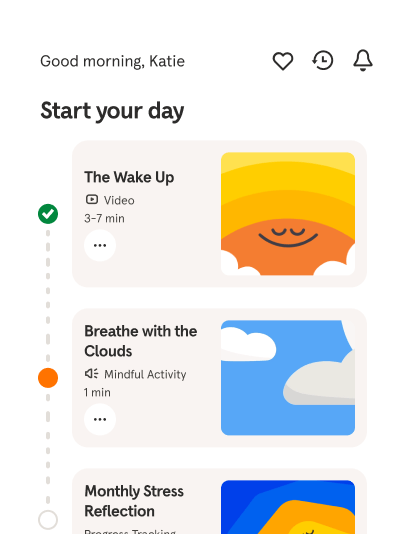Self-Compassion for Caregivers
When we learn to make space for our own difficult emotions, we can then provide a safe space for a child’s feelings in a similar way.
Get 50% offBetter mental health starts with Headspace. Unrivaled expertise to make life feel a little easier, using guided meditations, mindfulness tips, focus tools, sleep support, and dedicated programs.
Try 14 days free
Many of us have inherited the belief that we need to be hard on ourselves or self-critical in order to achieve and stay accountable. As caregivers and parents, we may get perfectionistic sometimes and forget that we need kindness and understanding too. Self-compassion involves greeting our pain or discomfort with presence, patience, and kindness. Research has shown that practicing self-compassion reduces rumination, encourages perspective taking, and promotes the resilience needed to bounce back from difficult moments. It also encourages us to be more caring and compassionate toward others while growing from our own mistakes. When we practice self-compassion, we're pausing to acknowledge our feelings through the lens of a compassionate friend or mentor, which allows us to greet others discomfort in a similar way. So let's start by finding a comfortable seated position. And when you get comfortable, just feel a lengthening in your spine, and a grounding of your body as it makes contact with the surface that you're resting on, and you can just rest your hands on your legs, or in another comfortable position, and then close your eyes if that's comfortable. And as we get started, just give yourself permission to arrive in stillness, allowing it to be a really smooth and gentle transition. See if you can imagine the ease that you feel when you're done with all of the day's tasks and it's just time to relax in whatever way you'd like. See if you can bring that ease to this moment as you let go of what you have to do later, and just arrive here in this precious stillness, and then just take a nice deep breath in through your nose, feeling your abdomen expand. And as you exhale through your nose, feel the belly relax back down. It's doing that a few more times tracing the path of a few deep and slow breaths. And now just let go of any effortful breathing, and allow your breath to find its own natural easy rhythm. And now we'll bring our spacious awareness to body sensations, listening to the body as we scan through it. So first, just notice where you feel your natural breath moving your body, maybe in the abdomen as it rises and falls, or maybe in your chest as you feel your lungs expanding and contracting, or maybe right at your nose, feeling the air as it enters and leaves the nose. And at any time in this practice you can always drop my guidance and just rest in whatever spot you naturally gravitate toward today. And now just witness your body seated here, become aware of the space around you, above you, below you, and the space on both sides of you. And feel the support of the space in the surface that you're resting on. Notice how it supports your body and your quiet stillness. Now, begin to notice how you're feeling at this moment. Notice if it's difficult or easy to be in stillness right now,...
Details
About your teachers
 Andy PuddicomeHeadspace Co-founderMore about Andy
Andy PuddicomeHeadspace Co-founderMore about AndyA former Buddhist monk, Andy has guided people in meditation and mindfulness for 20 years. In his mission to make these practices accessible to all, he co-created the Headspace app in 2010.
 Eve Lewis PrietoHeadspace Director of MeditationMore about Eve
Eve Lewis PrietoHeadspace Director of MeditationMore about EveEve is a mindfulness teacher, overseeing Headspace’s meditation curriculum. She is passionate about sharing meditation to help others feel less stressed and experience more compassion in their lives.
 Dora KamauMeditation TeacherMore about Dora
Dora KamauMeditation TeacherMore about DoraAs a meditation teacher, Dora encourages others to live, breathe, and be with the fullness of their experiences. She loves meditation’s power to create community and bring clarity to people’s minds.
 Kessonga GiscombeMeditation TeacherMore about Kessonga
Kessonga GiscombeMeditation TeacherMore about KessongaKessonga has been an acupuncturists, therapist, and meditation teacher, working to bring mindfulness to the diverse populations of the world.
 Rosie AcostaMeditation TeacherMore about Rosie
Rosie AcostaMeditation TeacherMore about RosieRosie Acosta has studied yoga and mindfulness for more than 20 years and taught for over a decade. Rosie’s mission is to help others overcome adversity and experience radical love.

Your lifelong guide to better mental health
Stress, sleep, and all the challenging emotions — care for your mind with the everyday mental health app that's shown to make a difference.
Try 14 days free
Look after your mind
Proven guided meditations and programs to help you stress less, sleep more soundly, and better navigate life’s challenges

Science-backed
Studies show that using Headspace for 30 days can reduce stress, increase resilience, and improve overall well-being

Explore 1000+ expert-led exercises
Access our library of meditations, breathing exercises, and guidance videos for stress, sleep, focus, everyday anxiety , parenting, and more.




Members are enjoying happier and healthier lives
Related to 'Self Compassion For'
- © 2025 Headspace Inc.
- Terms & conditions
- Privacy policy
- Consumer Health Data
- Your privacy choices
- CA Privacy Notice


